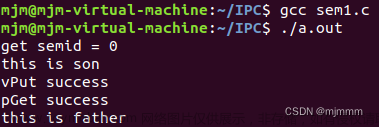要传输较大数据时,使用队列。
传输较小数值时,使用邮箱。
队列、邮箱用来传递数据。
如果只是用来传递资源的个数,可以使用信号量。

A车与B车只需要传递信号量(代表资源)。
信号量
获取信号量
- 如果value>0,value–,return OK;如果value0,timeout0,return -ETIMEOUT;如果value==0,timeout>0,从就绪链表移除(挂起),把自己记录在信号量的等待链表。
- 被唤醒:如果thread->err!=0,return thread->err;return EOK;
释放信号量
- value++;如果有等待信号量线程,唤醒线程。
创建信号量
/**
* This function will create a semaphore from system resource
*
* @param name the name of semaphore
* @param value the initial value of semaphore
* @param flag the flag of semaphore
*
* @return the created semaphore, RT_NULL on error happen
*
* @see rt_sem_init
*/
rt_sem_t rt_sem_create(const char *name, rt_uint32_t value, rt_uint8_t flag)
信号量结构体
struct rt_semaphore
{
struct rt_ipc_object parent; /**< inherit from ipc_object */
rt_uint16_t value; /**< value of semaphore. */
rt_uint16_t reserved; /**< reserved field */
};
struct rt_ipc_object
{
struct rt_object parent; /**< inherit from rt_object */
rt_list_t suspend_thread; /**< threads pended on this resource */
};
获取信号量
rt_err_t rt_sem_take(rt_sem_t sem, rt_int32_t time)
{
register rt_base_t temp;
struct rt_thread *thread;
/* parameter check */
RT_ASSERT(sem != RT_NULL);
RT_ASSERT(rt_object_get_type(&sem->parent.parent) == RT_Object_Class_Semaphore);
RT_OBJECT_HOOK_CALL(rt_object_trytake_hook, (&(sem->parent.parent)));
/* disable interrupt */
temp = rt_hw_interrupt_disable(); //关中断
RT_DEBUG_LOG(RT_DEBUG_IPC, ("thread %s take sem:%s, which value is: %d\n",
rt_thread_self()->name,
((struct rt_object *)sem)->name,
sem->value));
if (sem->value > 0) //如果有资源
{
/* semaphore is available */
sem->value --;
/* enable interrupt */
rt_hw_interrupt_enable(temp);
}
else
{
/* no waiting, return with timeout */
if (time == 0)
{
rt_hw_interrupt_enable(temp);
return -RT_ETIMEOUT;
}
else
{
/* current context checking */
RT_DEBUG_IN_THREAD_CONTEXT;
/* semaphore is unavailable, push to suspend list */
/* get current thread */
thread = rt_thread_self();
/* reset thread error number */
thread->error = RT_EOK;
RT_DEBUG_LOG(RT_DEBUG_IPC, ("sem take: suspend thread - %s\n",
thread->name));
/* suspend thread */
rt_ipc_list_suspend(&(sem->parent.suspend_thread),
thread,
sem->parent.parent.flag);
/* has waiting time, start thread timer */
if (time > 0)
{
RT_DEBUG_LOG(RT_DEBUG_IPC, ("set thread:%s to timer list\n",
thread->name));
/* reset the timeout of thread timer and start it */
rt_timer_control(&(thread->thread_timer),
RT_TIMER_CTRL_SET_TIME,
&time);
rt_timer_start(&(thread->thread_timer));
}
/* enable interrupt */
rt_hw_interrupt_enable(temp);
/* do schedule */
rt_schedule();
if (thread->error != RT_EOK)
{
return thread->error;
}
}
}
RT_OBJECT_HOOK_CALL(rt_object_take_hook, (&(sem->parent.parent)));
return RT_EOK; //获取到了资源成功返回
}
RTM_EXPORT(rt_sem_take);
释放信号量文章来源:https://www.toymoban.com/news/detail-684647.html
rt_err_t rt_sem_release(rt_sem_t sem)
{
register rt_base_t temp;
register rt_bool_t need_schedule;
/* parameter check */
RT_ASSERT(sem != RT_NULL);
RT_ASSERT(rt_object_get_type(&sem->parent.parent) == RT_Object_Class_Semaphore);
RT_OBJECT_HOOK_CALL(rt_object_put_hook, (&(sem->parent.parent)));
need_schedule = RT_FALSE;
/* disable interrupt */
temp = rt_hw_interrupt_disable();
RT_DEBUG_LOG(RT_DEBUG_IPC, ("thread %s releases sem:%s, which value is: %d\n",
rt_thread_self()->name,
((struct rt_object *)sem)->name,
sem->value));
if (!rt_list_isempty(&sem->parent.suspend_thread)) //是否有等待线程
{
/* resume the suspended thread */
rt_ipc_list_resume(&(sem->parent.suspend_thread));//唤醒++,接收--,所以没有对sem->value做任何操作。
need_schedule = RT_TRUE;
}
else
sem->value ++; /* increase value */
/* enable interrupt */
rt_hw_interrupt_enable(temp);
/* resume a thread, re-schedule */
if (need_schedule == RT_TRUE)
rt_schedule();
return RT_EOK;
}
RTM_EXPORT(rt_sem_release);
 文章来源地址https://www.toymoban.com/news/detail-684647.html
文章来源地址https://www.toymoban.com/news/detail-684647.html
到了这里,关于RT_Thread内核机制学习(六)信号量的文章就介绍完了。如果您还想了解更多内容,请在右上角搜索TOY模板网以前的文章或继续浏览下面的相关文章,希望大家以后多多支持TOY模板网!













